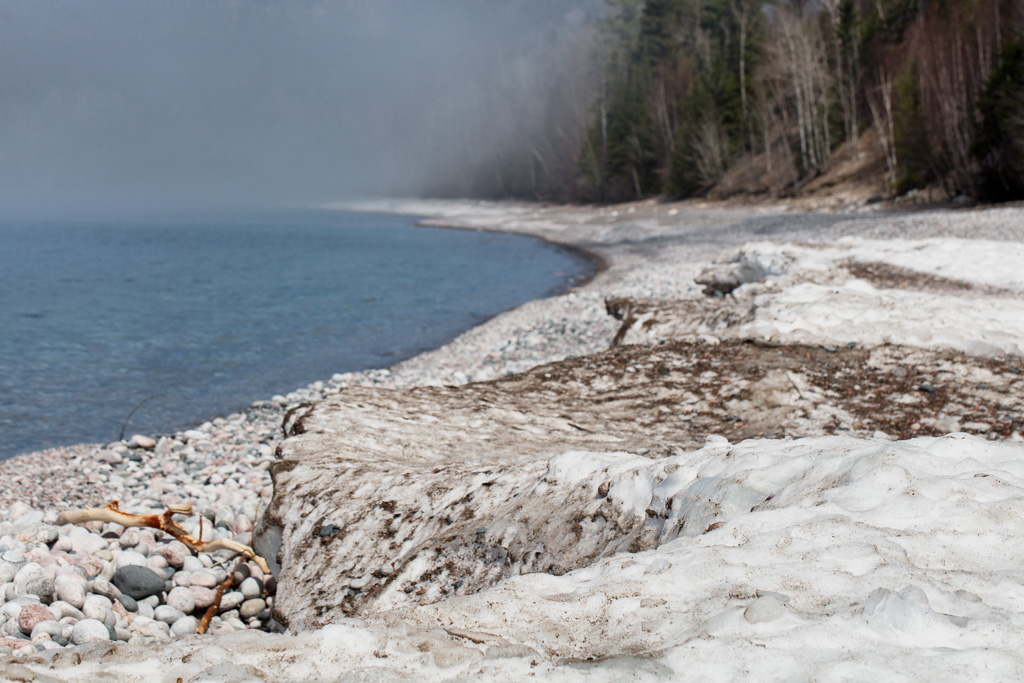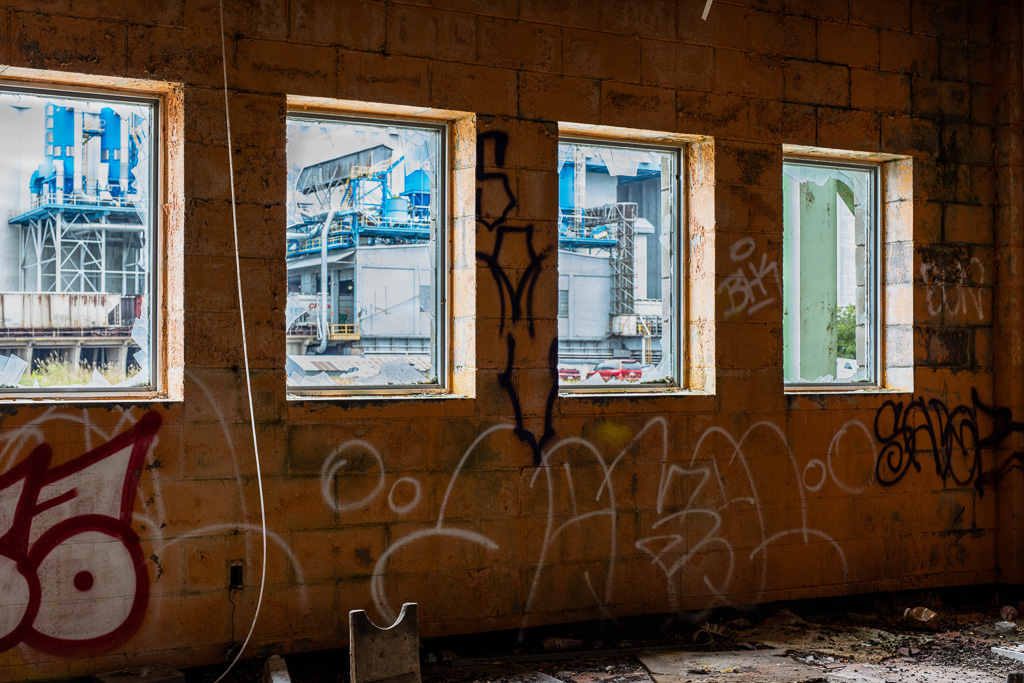I have a theory about the life-cycle of abandoned buildings, namely that abandoned buildings follow a fixed process of decay. It’s kind of like the book On Death And Dying where Elizabeth Kubler Ross sets out stages of grief as a person approaches death. Denial, anger, bargaining, etc. Buildings follow a similar process, and the first stage is invariably graffiti. People sneak in when nobody is looking and cover every reachable surface with spray paint. Stodgy middle-aged zombies whose bodies have been taken over by the souls of dead lawyers shake their heads and call the spray painters hoodlums and wonder what the world is coming to. But, really, what possible harm can it do to send an otherwise drab hunk of concrete out in a splash of colour?
Following close on the graffiti stage, so close in fact that many people mistakenly believe it’s just an extension of the graffiti stage, is the window and drywall smashing stage. Probably it’s the same group of people who covered everything in spray paint. Once the cans are empty, the spray painters pull out crowbars, hammers, broom handles, whatever’s close at hand, and set to smashing furniture, old office equipment, drywall, ceiling tiles, light fixtures, and windows. Graffiti and Smashing are distinct phases and the evidence for this is on the windows. Nobody smashes a window if they can cover it with graffiti first.
Next comes the Scavenging phase. Trespassers of a different sort enter the site to salvage what they can of copper wire and pipe, hinges, screws, heating ducts, vent covers.
At this point, a building’s decay follows one of two possible paths depending on whether it’s a city building or a rural building. In cities, where property values are higher and there are more zombie lawyers wandering the streets, there is a greater incentive to move things along. Assisted deaths are common as the propertied make way for fresh buildings. Time accelerates and death assumes an unnatural aura. It’s as if the skeleton holding the scythe arrives, not in a black cloak, but in steel-toed boots and a hard hat. But the further you get from the city, the more time unwinds. Buildings are left to die as nature intended—or as nature would have intended had nature been consulted when humans first came up with idea of creating durable structures. Graffiti’d, smashed, and plundered, rural buildings moulder in the elements, gradually sinking back into the land they tried to dominate, and finally merging with that land to share in a more expansive way of being. As buildings approach this ultimate dissolution, they undergo a shift from human time to geologic time, no longer measuring the transformation in human heartbeats, but in the barely discernible rhythm of tectonic rumbles.
Toronto is my hometown and, there, the opportunities to document the death of buildings is fleeting. A fire breaks out. I capture some of the ruination. Then the insurance adjusters swoop in with their fences and CCTV’s and security patrols. Demolition crews cart away the rubble and within weeks the site is a parking lot. I do better north of the city. My daughter lives in Thunder Bay, so I often make the drive up Highway 69 to Sudbury, then west on Highway 17 to the Sault, north up the eastern shore of Superior to Wawa and west from there. I have my usual stops along the way where, for years, I have paid my respects to familiar buildings in their protracted death throes.
First is the Long Branch Hotel in Still River north of Parry Sound. It’s one of the few abandoned buildings where I’ve met the owner on site and have heard something of the building’s story. In this case, the hotel’s demise can be chalked up to Late Capitalism. It couldn’t compete with the big chains that offer hot tubs in every bathroom and doe-eyed maids from exotic lands. Maybe “exotic” isn’t the right word for “exploits immigrants for cheap labour” but I was trying to be polite. I was invited to make an offer for the property but declined as it would take the magic of Jesus to resurrect this Lazarus and I just don’t have it in me.
Not far from Still River is the mostly defunct town of Burwash and the nearby Camp Bison Prison Farm, abandoned to the elements these past 45 years. I have not met the current owner as it has changed hands since I last visited. At that time, I met the previous owner’s proxy, a guy named Dave who protected the site from vandals, a task which struck me as mythic for the sheer scale of its fruitlessness.
There is a dead garage in the classically named village of Thessalon. North of the Sault, in the village of Heyden, there is Pruce’s Motor Inn which looks as if someone drove a tank through the middle of it before setting it on fire. Ironically, there is a fire station next door. I wonder if maybe this fire station is a fire station in the spirit of Ray Bradbury’s Fahrenheit 451. Not far from the Algoma tourist centre is the remains of another garage. Then, 38 km east of Nipigon, there is a garage that I used to stop and photograph until somebody torched it into oblivion. On the other side of Nipigon, in the town of Dorion, there is another burnt out motel. Initially, the owners kept people out with a temporary fence, just like in the city, but 1300 km from Toronto nobody takes these things seriously. Finally, we have Thunder Bay itself where the ruins of grain elevators watch over the town. These are like the hulking remains of a dead alien creature, the mother of all ruins.
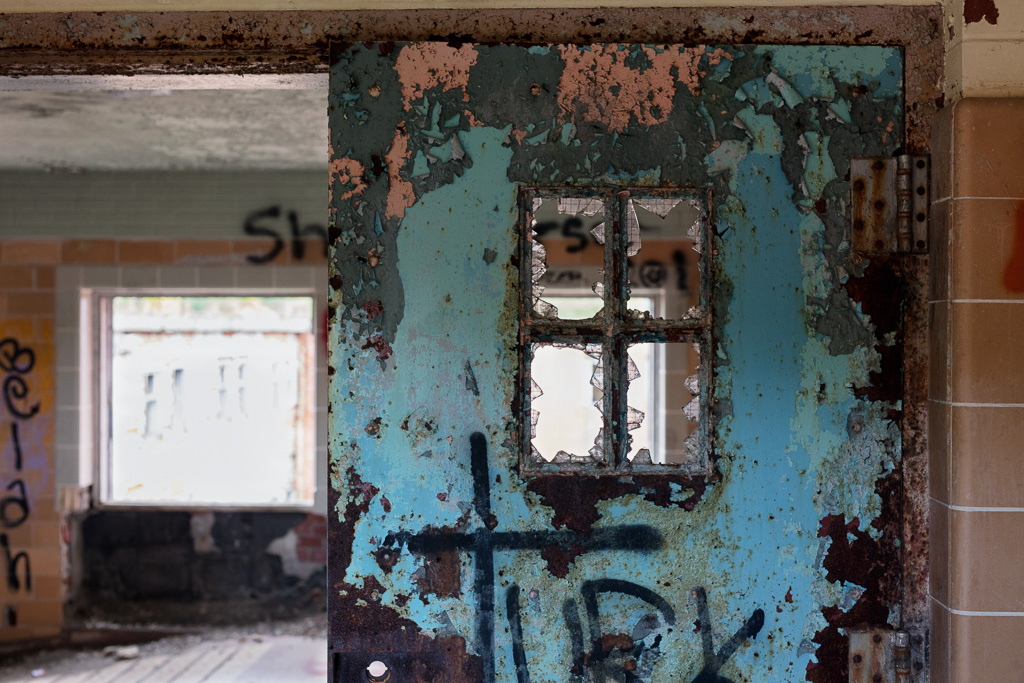
At various times, I’ve explored all these sites and I like to revisit them to monitor their decay. Sadly, on my most recent drive to Thunder Bay, I wasn’t able to give them the attention they deserve. We had arranged to bring our daughter back to the city so she could finish her last year of school. The first day of her final term was April 12th. We had booked a full-size SUV from a rental agency so we’d have something big enough to haul all her important belongings down to the city. And then, on the afternoon before the day of our big drive north, Doug Ford announced a stay-at-home order: nobody should go out except for essential purposes. Well, shit!
Our daughter phoned the school to see if they’d accommodate a delayed arrival but they said absolutely not. Ironically, the school, which I won’t name, trains health care professionals. (As it turns out, the school found it necessary to close a week later.) I downloaded the text of the new regulation and read it front to back to see if it contemplated retrieving daughters from Northern Ontario. On my reading, it all boiled down to an interpretation of the word “essential”. I don’t know. Is my daughter essential? I think it’s telling that the regulation occupies itself almost exclusively with commercial and retail activities. When Ford’s cabinet and their attendant lawyers were hammering out the language for the new regulation, I don’t think they were contemplating what we wanted to do; more likely, they had in mind the crowds that had massed at Yorkdale on the preceding weekend. I think of Ford standing at his podium speaking in his most unctuous patronizing voice: “Geez, folks, why would do this?” And people throwing it back in his face: “Because ya said it was okay, ya fat fuck.”
We decided we’d make the trip and hoped the OPP wouldn’t stop us along the way. We would have relaxed a little had we known what would happen a week later when Ford tried to give police the power to conduct random stops and the police pushed back, saying there was no way they were going to enforce his regs. Ah, well, hindsight is 2020. This is 2021.
She said we hadn’t told her about our pet; we had to pay for our pet; pets are extra. I said we didn’t have a pet. She said the maid had gone into our room and it smelled like wet dog.
According to Google Maps, the trip door to door from our condo in downtown Toronto to our daughter’s rental in Thunder Bay is 1389 km and takes 14 hours and 30 minutes. We turned onto Bloor at 4:30 in the morning and pulled into the parking lot of Both Hands Pizza on Algoma shortly before 7:00 in the evening. (Our daughter doesn’t live in Both Hands Pizza; that’s where her boyfriend works and that’s where we were getting our supper.) Along that whole stretch of highway (the UK equivalent of driving from Penzance to Wick and then some), we encountered only one patrol car. As it passed us, I quoted a different Ford (of the Harrison variety) when he and Chewbacca are trying to sneak into Imperial space: “I don’t know, fly casual.” The Imperial cruiser drifted on by and we never saw it again.
On the drive up, the sun rose somewhere north of Parry Sound and we breezed past a moose by the side of the road. We zoomed through Still River and I noted that the main beam supporting the roof of the Long Branch Hotel had broken. I suspect a total collapse is imminent. Sadly, we were on a tight schedule and couldn’t stop for photos. We stopped for gas in Sudbury and my wife took a pee break in Northern Ontario’s universal pee break facility otherwise known as Tim Horton’s. Scattered throughout the parking lot, there were guys my age in baseball caps and goatees doing the coffee tailgate thing, and the line at the drive-thru never let up. If there was a provincial stay-at-home order, you’d never know it by all the people out and about in Sudbury. We noted the same thing in Sault Ste Marie where, again, my wife took a pee break at the Tim Horton’s.
You may wonder why I took no pee breaks. The answer is that I’m stupid. I was trying to set a road trip record of no pee breaks until Thunder Bay. With two coffees and a canteen of water in my bladder, I opened the sluice gates at the Algoma Visitor Centre. Although the Visitor Centre was closed, the bushes were open. I paused for a short stroll on the eastern shore of Lake Superior and then we were on our way.
Driving into Wawa, we nodded to our right where the Mystic Isle Motel overlooks the highway. We stayed there once a few years ago and, after we left, took a phone call from the owner. She said we hadn’t told her about our pet; we had to pay for our pet; pets are extra. I said we didn’t have a pet. She said the maid had gone into our room and it smelled like wet dog. I hung up. Our stay at the Mystic Isle Motel was not a complete bust. In need of dinner, we had gone across the highway to the Kinniwabi Pines restaurant. Improbably (from a hoity-toity Toronto point of view), Wawa is home to a brilliant Caribbean/Asian fusion restaurant with a wonderful wine list. The next time we stayed in Wawa, we checked in at the Wawa Motor Inn, quite possibly the only motel in Northern Ontario that will never die in abandonment. The reason is that Glenn Gould summered there and always booked room 101. To this day, Glenn Gould nutcases vie with one another for the chance to spend a night in room 101. Even if the motel goes belly up, some level of government will declare it a national historical site and armed guards will keep the graffiti artists at bay.
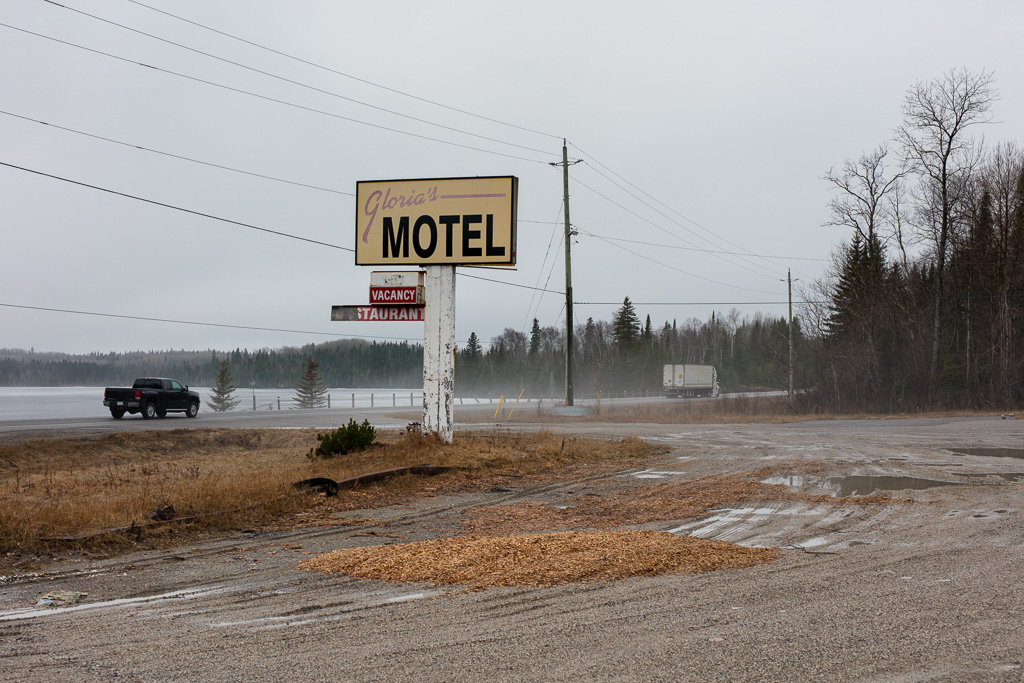
We skirted around Wawa and passed the sign that told us we had only 481 km left in our drive. Roughly half way between White River and Marathon (another of those classically named towns), we passed Dunc Lake and I discovered a new addition to my personal list of abandoned buildings: Gloria’s Motel. The last time I passed this way, it was a going concern. Now, the two-story structure is covered in graffiti, windows shattered, doors torn off their hinges, chairs and smashed TVs scattered in the parking lot. I must investigate. I bookmarked it for our return trip.
We stayed in Thunder Bay for a day. It wasn’t much of a stay. We hardly went out. Nobody there wants to interact with people from Toronto. We went for a walk where we knew we wouldn’t encounter other people. Later, we picked up dinner from Tomlins, another of those amazing restaurants in Northern Ontario. We loaded everything into the rental for the return trip and went to bed early.
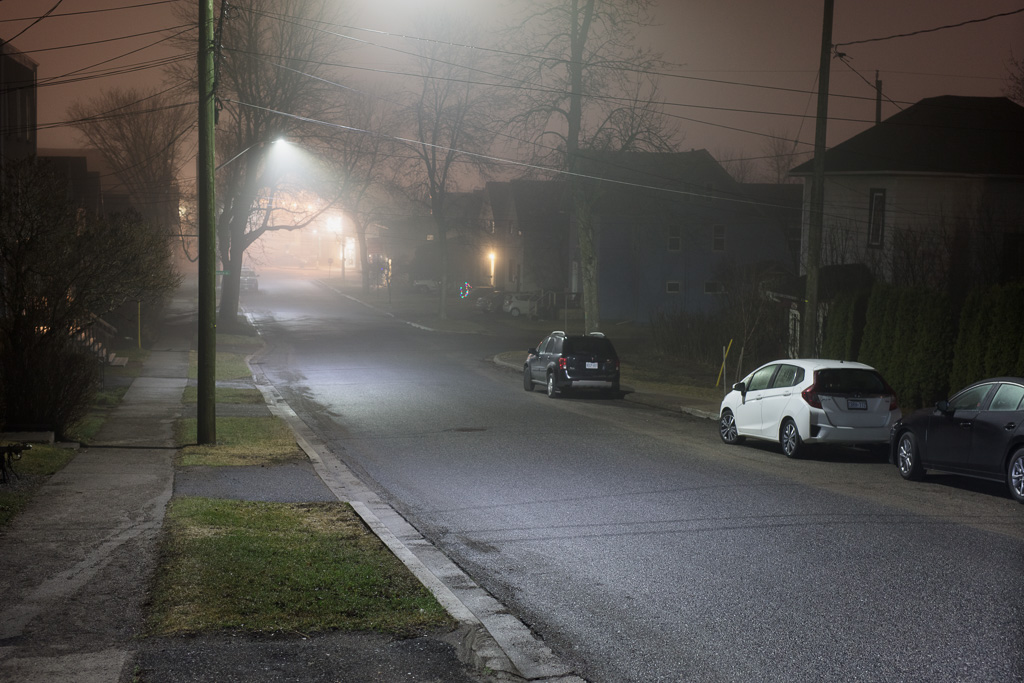
The next morning, we left in a fog that, as we later discovered, blanketed the entire north shore of Lake Superior. Just what we needed: one more cause of anxiety heaped on all the others. Well before lunchtime, we pulled into the parking lot of Gloria’s Motel overlooking Dunc Lake. I can’t say for certain why Gloria’s Motel went out of business, but I suspect it’s a casualty of Covid-19. We can probably apply the same statistical modelling to motels that we apply to infectious diseases. We can say that in a given set of conditions, Covid-19 will infect X number of people over Y period of time, and this will result in Z number of deaths. When it comes to an epidemiology of tourism, we can probably offer a similar model. We can’t say exactly which businesses will expire in a pandemic, but we can say with some degree of accuracy what number of businesses will expire. Surprisingly, the Mystic Isle Motel still appears to be a going concern. Meanwhile, Gloria’s Motel has undergone a catastrophic decline. What set of conditions led to this outcome? Were they pre-existing conditions? Co-morbidities?
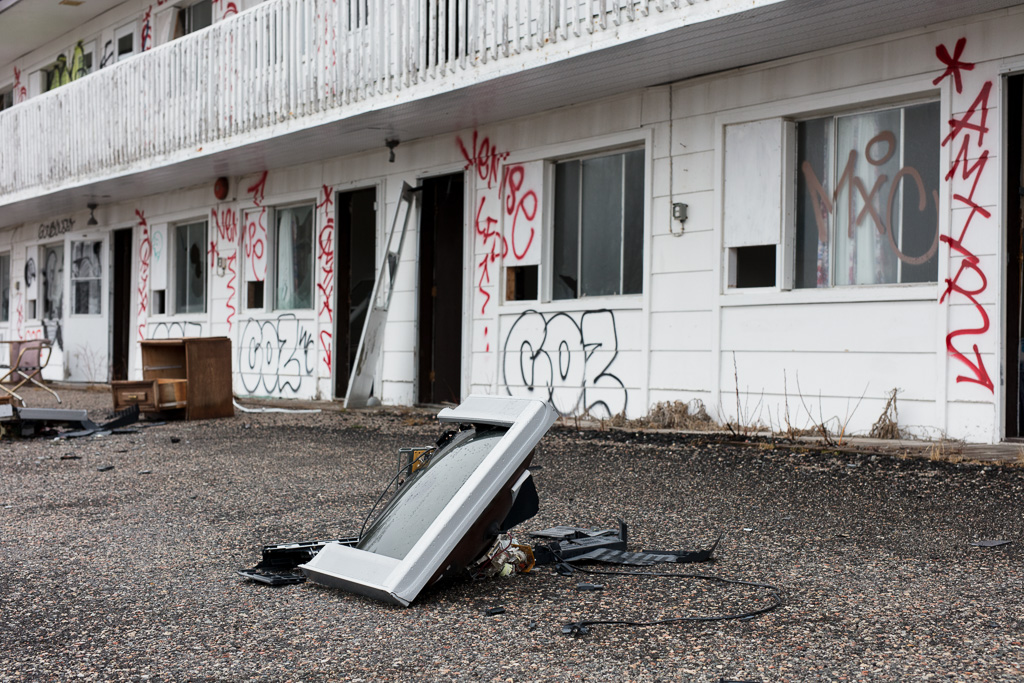
Pulling out my camera, I step from the car and walk to the long porch that fronts the main building’s ground floor. I feel like a coroner examining the wounds in my search for a cause of death. I approach the building with solemnity; this has been the site of grief. People’s lives have come apart here. I note the graffiti on the smashed glass. Graffiti first. Smashing later. Peering into the easternmost room, I note rumpled sheets and a pillow on the bed and wonder if maybe someone has slept here recently, maybe during the preceding night. It would be chilly but not unbearable.
If I had made this trip alone, as I sometimes do, I would have lingered for a time, asking more of the building, seeing if I couldn’t summon up some of the ghosts that still haunt this place. But I’m cognizant that I have a wife and daughter waiting for me in the car, and I’m cognizant too that the air is heavy not just with the last wisps of fog but with something else—the heaviness of a free-floating anxiety. We need to be on our way.
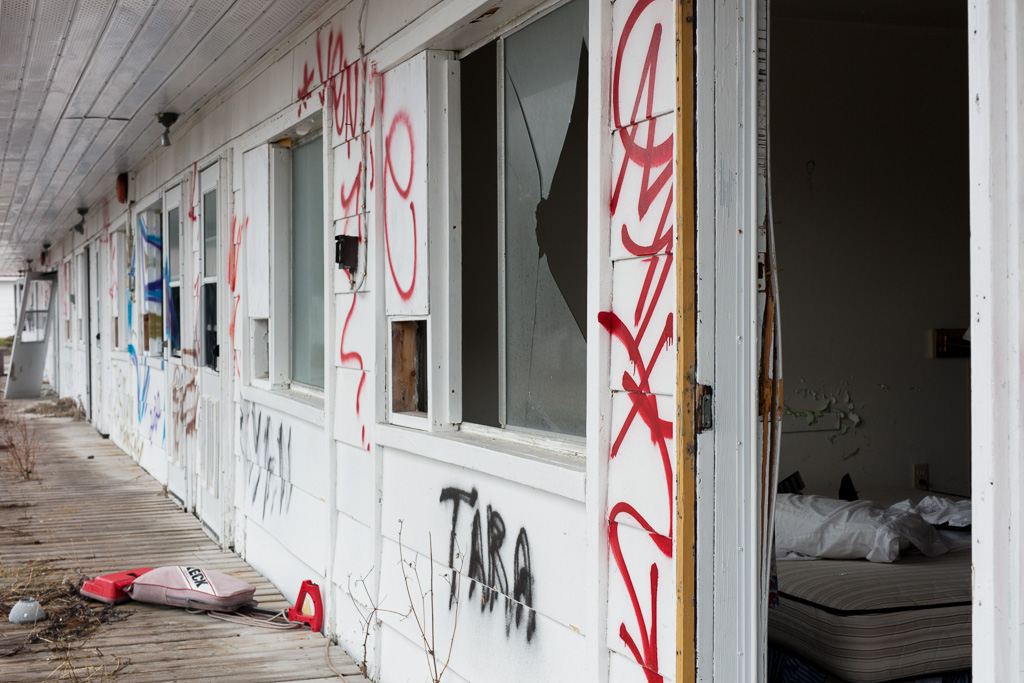
We turn south at Wawa and halfway down the eastern shore, our daughter tells us to pull off the highway. We’re at Alona Bay where she and her boyfriend like to camp. We pause for a lunch break and my daughter and I climb down to the beach where she scavenges for smooth rocks while I take shots of the ice, using the last of the fog as an atmospheric backdrop. Melt water drains into the lake and a family dressed in rubber boots comes down with fishing poles and nets. We climb back up to the car in time to witness the arrival of the only active law enforcement I have ever encountered on all my travels along highway 17, a wildlife conservation officer. When he steps out of his truck, I see that he’s wearing camouflage greens, rubber boots and, if I’m not mistaken, a Kevlar vest. He leans into the radio fixed to a shoulder strap and advises his dispatcher or whoever is on the other end that he’s at Alona Bay and headed down to the beach. As he walks past me, we exchange nods. Oddly, neither of us is wearing a mask.
A few minutes later, we’re still munching on snacks when the family returns with their fishing poles and nets, heads lowered and muttering what I can only surmise are nasty curses at the enforcement officer. From an urban Covid point of view, this is a strange moment. It’s off season and here I am, a city boy, standing on the shore of the largest lake in the world, with so much space around me I feel myself shrinking to the size of an ant. Nobody cares that I’m here. Certainly none of the locals. I barely exist. For them, it’s all about the fish. As for the graffiti-covered shells of roadside motels and abandoned gas stations, in 20 years, they’ll all be level with the ground; in 100 years, they’ll be buried underneath a layer of moss and pine needles where they can listen to the whispered secrets of the Precambrian rock that’s lain here for more than a billion years.
